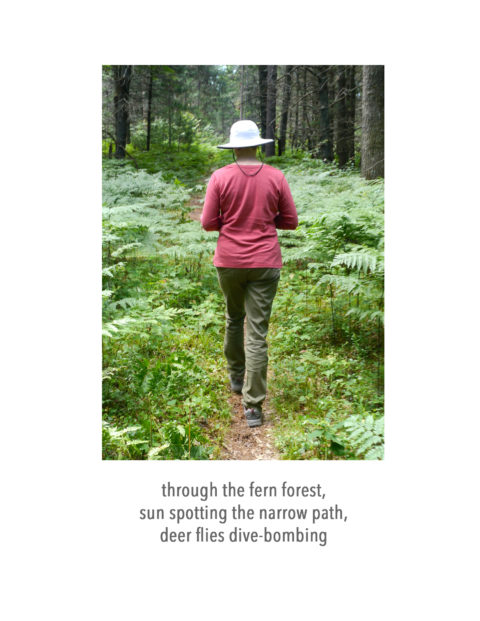 Haiku is a form of poetry that originates from Japan. It usually consists of three lines, containing five, seven, and five syllables respectively. These three lines pare an experience down to its essence. There is no interpretation; you say what happened or what you observed in a few well-chosen words.
Haiku is a form of poetry that originates from Japan. It usually consists of three lines, containing five, seven, and five syllables respectively. These three lines pare an experience down to its essence. There is no interpretation; you say what happened or what you observed in a few well-chosen words.
I find that these types of poems are perfect accompaniments to contemplative photographs. The words succinctly describe the experience of the moment without judgment. Charles Blackhall calls them “eyeku.”
Last week, we were in Northern Michigan with my step-sister and her husband. A walk in the woods was both wonderful and annoying in equal measure, as you can see and read in the image and haiku here.
In her book, The True Secret of Writing, author Natalie Goldberg introduces Shiki, a great haiku writer from the 19th century. He was “an invalid, who dragged himself to the edge of the tatami mat, overlooking his garden, where he sat all day waiting to receive the right words. For Shiki, the act of creating entailed an alert stillness.”
Goldberg says that “simple attention shifts reality” and “much can be done by doing little – with regard.”
You can try this yourself with one of your own photographs. Describe a moment of simple attention, using words that come from your observations, rather than what you “think” about the experience. This type of writing is one we explore in Session 2 of the visual journaling workshop, Once Upon a Time: Your Photographs have Stories to Tell.
** Books mentioned have Amazon or Bookshop affiliate links, meaning I make a few cents if you purchase through my link. I only recommend books that I’ve read.
Read about Basho, a master of haiku at The Book of Life
When there is stillness
Haiku finds its path within
like a melody
It certainly sings to me like a song which encompasses what I see with what I feel! I enjoyed checking out all your links and I also loved the painting of ‘the yellow rose petals’ by Matsuo Basho with his accompanying Haiku.
There’s a wonderful little book by Jane Hirshfield about the history of haiku and Basho in particular.
I’m so happy you brought up the topic of Haiku. For the final year before my daddy passed away from Alzheimer’s, I photographed and accompanied his thoughts into Haiku. It made for a wonderful combination and I’ll treasure those images and words forever. You inspire me to return to it. Thank you.
That would be a perfect time to practice haiku, to remember the beauty and the difficulty together.
I have always been such a fan of the combination of simplicity and depth that is haiku. I love the way you have captured the story of this image in your poem.
Thank you, Brenda.
Hi, Kim. I came across your post as I was looking for examples of “eyeku” for my creative writing class. I didn’t want to just share my own, so I hope you don’t mind me linking my students to yours.
Of course not, Michael. I’m honoured that you would do so.